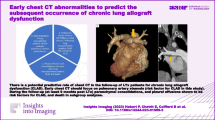Abstract
Objectives
To describe the CT changes in patients with restrictive allograft syndrome (RAS) after lung transplantation, before and after clinical diagnosis.
Methods
This retrospective study included 22 patients with clinical diagnosis of RAS. Diagnosis was based on a combination of forced expiratory volume (FEV1) decline (≥20 %) and total lung capacity (TLC) decline (≥10 %). All available CT scans after transplantation were analyzed for the appearance and evolution of lung abnormalities.
Results
In 14 patients, non-regressing nodules and reticulations predominantly affecting the upper lobes developed an average of 13.9 months prior to the diagnosis of RAS. Median graft survival after onset of non-regressing abnormalities was 33.5 months, with most patients in follow-up (9/14). In eight patients, a sudden appearance of diffuse consolidations mainly affecting both upper and lower lobes was seen an average of 2.8 months prior to the diagnosis of RAS. Median graft survival was 6.4 months after first onset of non-regressing abnormalities, with graft loss in most patients (6/8).
Conclusions
RAS has been previously described as a homogenous group. However, our study shows two different groups of RAS-patients: one with slow progression and one with fast progression. The two groups show different onset and progression patterns of CT abnormalities.
Key points
• RAS is the newest discovered form of chronic lung allograft dysfunction (CLAD).
• RAS is not a homogenous group, as survival varies greatly between patients.
• In this study, we see two different CT onset and progression patterns.
• These two different CT patterns also correlate with a different survival rate.



Similar content being viewed by others
Abbreviations
- RAS:
-
Restrictive allograft syndrome
- CLAD:
-
Chronic lung allograft dysfunction
- BOS:
-
Bronchiolitis obliterans syndrome
- NRAD:
-
Neutrophilic reversible allograft dysfunction
- ARAD:
-
Azithromycin reversible allograft dysfunction
- CT:
-
Computed tomography
- HRCT:
-
High-resolution CT
- FEV1:
-
Forced expiratory volume in 1 second
- TLC:
-
Total lung capacity
- PFT:
-
Pulmonary function testing
- PPFE:
-
Pleuroparenchymal fibroelastosis
- AFOP:
-
Acute fibrinoid organizing pneumonia
- PACS:
-
Picture archiving and communication system
References
Yusen RD, Edwards LB, Kucheryavaya AY et al (2014) The registry of the International Society for Heart and Lung Transplantation: thirty-first adult lung and heart-lung transplant report. J Heart Lung Transplant 33:1009–1024
Trulock EP, Edwards LB, Taylor DO et al (2005) The registry of the International Society for Heart and Lung Transplantation: twenty-second adult lung and heart-lung transplant report. J Heart Lung Transplant 24:956–967
Woodrow JP, Shlobin OA, Barnett SD et al (2010) Comparison of bronchiolitis obliterans syndrome to other forms of chronic lung allograft dysfunction after lung transplantation. J Heart Lung Transplant 29:1159–1164
Verleden GM, Vos R, Verleden SE et al (2011) Survival determinants in lung transplant patients with chronic allograft dysfunction. Transplantation 92:703–708
Verleden SE, Vandermeulen E, Ruttens D et al (2013) Neutrophilic reversible allograft dysfunction (NRAD) and restrictive allograft syndrome (RAS). Semin Respir Crit Care Med 34:352–360
Verleden GM, Raghu G, Meyer KC et al (2014) A new classification system for chronic lung allograft dysfunction. J Heart Lung Transplant 33:127–133
Verleden GM, Vos R, Vanaudenaerde B et al (2015) Current views on chronic rejection after lung transplantation. Transpl Int 28:1131–1139
Sato M (2013) Chronic lung allograft dysfunction after lung transplantation: the moving target. Gen Thorac Cardiovasc Surg 61:67–78
Verleden SE, Ruttens D, Vandermeulen E et al (2015) Restrictive chronic lung allograft dysfunction: where are we now? J Heart Lung Transplant 34:625–630
Verleden SE, de Jong PA, Ruttens D et al (2014) Functional and computed tomographic evolution and survival of restrictive allograft syndrome after lung transplantation. J Heart Lung Transplant 33:270–277
Sato M, Waddell TK, Wagnetz U et al (2011) Restrictive allograft syndrome (RAS): a novel form of chronic lung allograft dysfunction. J Heart Lung Transplant 30:735–742
Sato M, Hwang DM, Wadell TK, Singer LG, Keshavjee S (2013) Progression pattern of restrictive allograft syndrome after lung transplantation. J Heart Lung Transplant 32:23–30
Konen E, Weisbrod GL, Pakhale SS et al (2003) Fibrosis of the upper lobes: a newly identified late-onset complication after lung transplantation? AJR Am J Roentgenol 181:1539–1543
Pakhale SS, Hadjiliadis D, Howell DN et al (2005) Upper lobe fibrosis: a novel manifestation of chronic allograft dysfunction in lung transplantation. J Heart Lung Transplant 24:1260–1268
Ofek E, Sato M, Saito T et al (2013) Restrictive allograft syndrome post lung transplantation is characterized by pleuroparenchymal fibroelastosis. Mod Pathol 6:350–356
Paraskeva M, McLean C, Ellis S et al (2013) Acute fibrinoid organizing pneumonia after lung transplantation. Am J Respir Crit Care Med 12:1360–1368
Vos R, Verleden SE, Ruttens D et al (2013) Pirfenidone: a potential new therapy for restrictive allograft syndrome? Am J Transplant 13:3035–3040
Kohno M, Perch M, Andersen E et al (2011) Treatment of intractable interstitial lung injury with Alemtuzumab after lung transplantation. Transplant Proc 43:1868–1870
Verleden SE, Todd JL, Sato M et al (2015) Impact of CLAD phenotype on survival after lung retransplantation: a multicenter study. Am J Transplant 15:2223–2230
Acknowledgments
The scientific guarantor of this publication is Walter De Wever, MD PhD. The authors of this manuscript declare no relationships with any companies whose products or services may be related to the subject matter of the article. The authors state that this work has not received any funding. No complex statistical methods were necessary for this paper. Institutional Review Board approval was obtained. Written informed consent was not required for this study because of the retrospective nature.
Methodology: retrospective, diagnostic /observational study, performed at one institution.
Author information
Authors and Affiliations
Corresponding author
Rights and permissions
About this article
Cite this article
Dubbeldam, A., Barthels, C., Coolen, J. et al. Restrictive allograft syndrome after lung transplantation: new radiological insights. Eur Radiol 27, 2810–2817 (2017). https://doi.org/10.1007/s00330-016-4643-5
Received:
Revised:
Accepted:
Published:
Issue Date:
DOI: https://doi.org/10.1007/s00330-016-4643-5




